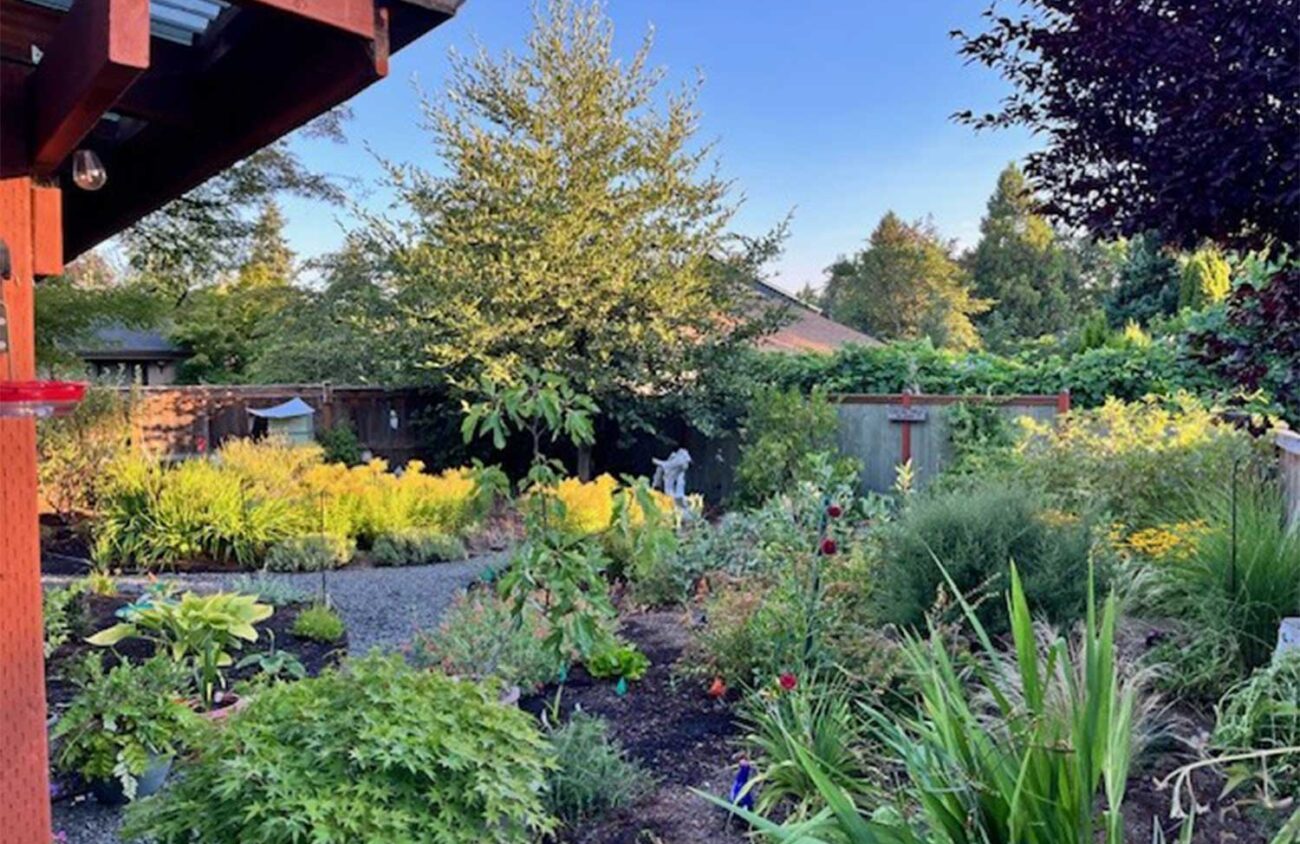Six years ago, my sweetie and I moved from a home with a very diverse and interesting garden in the South Hills to a more normal plot in the flatlands of north Eugene. After a depressing summer sitting on the back deck overlooking one lone, dying birch and a grass desert with a few dandelions visited upon occasion by a bumble bee, we both agreed we wanted to create a habitat where a variety of insects and birds could visit and flourish.
I found a landscape designer who created a terrific design, and we got to work removing the grass and the poor birch, bringing in a huge amount of soil, punctuated by a wandering path and water feature.
In the meantime, as that work was being done, we went on the hunt for the plants specified in the design. Even though it was spring, we could not find some of the exact plants, so we had to pivot to other look-alikes. Be prepared for this and be flexible if you take on a redesign. The large anchor shrubs — a red twig dogwood for a constantly wet area, (whose girth has expanded beyond her designated plot, requiring pruning twice a year), autumn jazz viburnum, Western hemlock, white alder, ceanothus and elderberry are mostly natives and have done extremely well.
The ornamentals I wanted for color and diversity, not so much. Over the ensuing years I’ve had to replace plants and have done that with natives. I have read in several publications that it’s ideal to have at least 70 percent native flora in your garden if you want to attract local fauna.
You will want a watering system to deliver consistent water to your new plants. The landscape designer can help advise you on that — or you can research it yourself.
Above ground, if you want to attract wildlife, water must be running and clean-ish. Birds love the water column we have. Yes, it requires a pump and a power source but it runs all year, giving the critters fairly fresh water when they need it most — in the heat of the summer and the depth of winter. Whatever water feature you use, make sure you know its tolerance for cold.
The native plants have brought in more diverse birds because — well, native birds eat native fruit and seeds and insects. Throughout late spring and well into September, the broad assortment of insects amazes us. Some birds like to snack on them, especially hummingbirds. We live on a noisy street and yet we see finches, warblers, bushtits, the odd towhee and red-breasted nuthatch, several flickers and downy woodpeckers (we do put cakes out), and last week we had a newly fledged Cooper’s hawk perched on the water column for at least 10 minutes, just taking it in, watching the finches. Seeing that hawk was quite a treat.
It’s expensive to do what we did — put in landscaping and plants all at once — but you can do it area by area, year by year. You just need to know why you want the plants you want. (Is it for wildlife or looks?) There are many free resources for advice here in the valley.
We also haven’t used herbicides or insecticides in any garden for at least 30 years — the verdict is clear that they are not good for nature or humans. Instead, every autumn, I collect fallen leaves from the neighbors and put them over last year’s mulch, as many leaves as I can. This not only keeps weeds down but creates habitat for baby insects, and it builds incredible soil. We had a huge hatch of ladybugs this year, and I can only attribute that to the massive amount of leaves I brought in. As I was planting today, big fat worms were everywhere — a testament to healthy soil and very different from six years ago.
I am not a great gardener. I learned by making mistakes at every turn. We all do. The key is finding the great gardeners in the area and asking for help. I don’t know a single one who would say “No.”
The Garden Palette is Kim Kelly, editor; Cynthia Lafferty of Doak Creek Native Plants; Rachel Foster, master gardener; Alby Thoumsin, ISA certified arborist of Sperry Tree Care; and Dan Gleason of Wild Birds Unlimited. Have a question for the writers? Gardening@EugeneWeekly.com.
